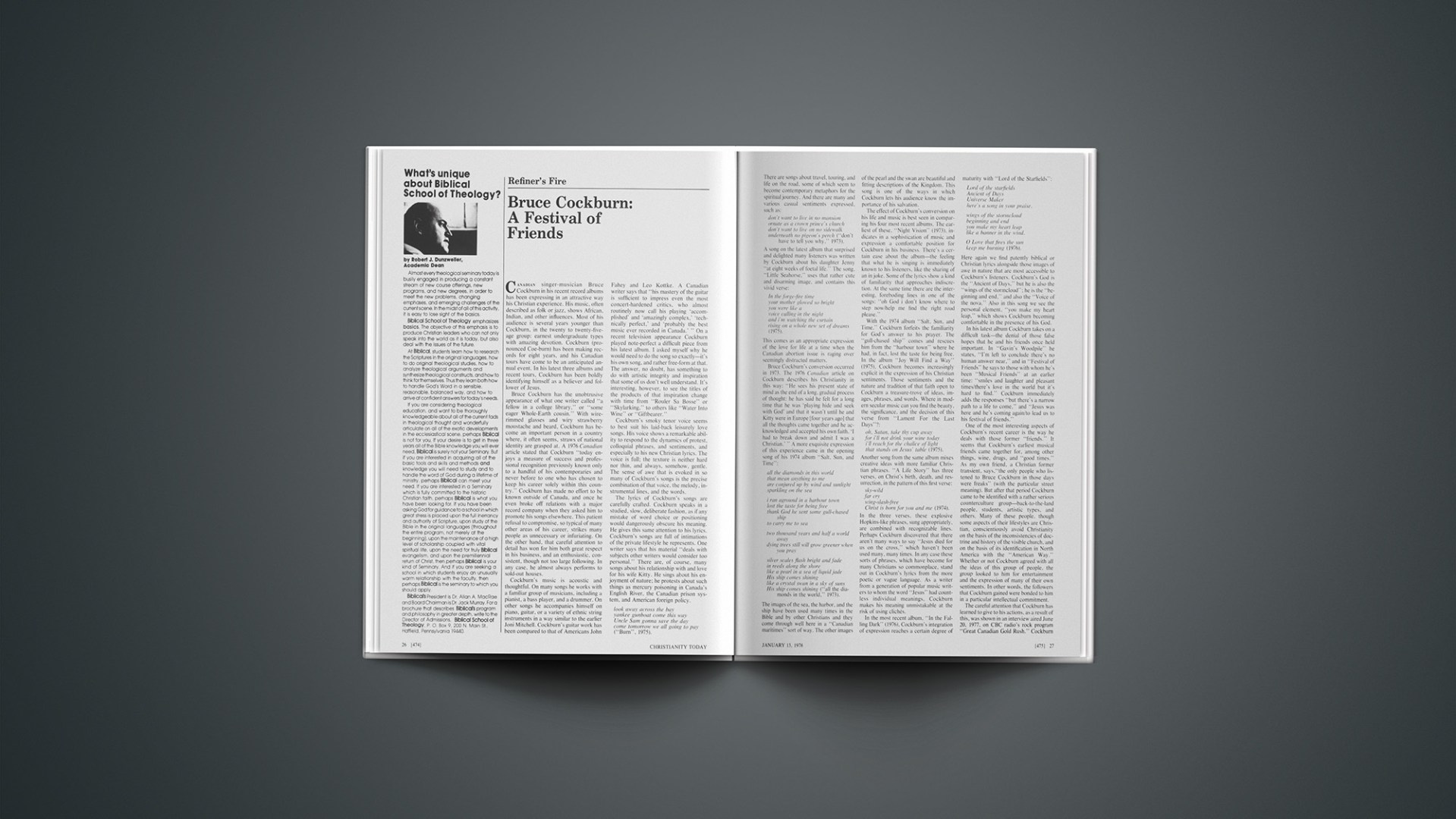Canadian singer-musician Bruce Cockburn in his recent record albums has been expressing in an attractive way his Christian experience. His music, often described as folk or jazz, shows African, Indian, and other influences. Most of his audience is several years younger than Cockburn, in the twenty to twenty-five-age group: earnest undergraduate types with amazing devotion. Cockburn (pronounced Coe-burn) has been making records for eight years, and his Canadian tours have come to be an anticipated annual event. In his latest three albums and recent tours, Cockburn has been boldly identifying himself as a believer and follower of Jesus.
Bruce Cockburn has the unobtrusive appearance of what one writer called “a fellow in a college library,” or “some eager Whole-Earth cousin.” With wire-rimmed glasses and wiry strawberry moustache and beard, Cockburn has become an important person in a country where, it often seems, straws of national identity are grasped at. A 1976 Canadian article stated that Cockburn “today enjoys a measure of success and professional recognition previously known only to a handful of his contemporaries and never before to one who has chosen to keep his career solely within this country.” Cockburn has made no effort to be known outside of Canada, and once he even broke off relations with a major record company when they asked him to promote his songs elsewhere. This patient refusal to compromise, so typical of many other areas of his career, strikes many people as unnecessary or infuriating. On the other hand, that careful attention to detail has won for him both great respect in his business, and an enthusiastic, consistent, though not too large following. In any case, he almost always performs to sold-out houses.
Cockburn’s music is acoustic and thoughtful. On many songs he works with a familiar group of musicians, including a pianist, a bass player, and a drummer. On other songs he accompanies himself on piano, guitar, or a variety of ethnic string instruments in a way similar to the earlier Joni Mitchell. Cockburn’s guitar work has been compared to that of Americans John Fahey and Leo Kottke. A Canadian writer says that “his mastery of the guitar is sufficient to impress even the most concert-hardened critics, who almost routinely now call his playing ‘accomplished’ and ‘amazingly complex,’ ‘technically perfect,’ and ‘probably the best music ever recorded in Canada.’ ” On a recent television appearance Cockburn played note-perfect a difficult piece from his latest album. I asked myself why he would need to do the song so exactly—it’s his own song, and rather free-form at that. The answer, no doubt, has something to do with artistic integrity and inspiration that some of us don’t well understand. It’s interesting, however, to see the titles of the products of that inspiration change with time from “Rouler Sa Bosse” or “Skylarking,” to others like “Water Into Wine” or “Giftbearer.”
Cockburn’s smoky tenor voice seems to best suit his laid-back leisurely love songs. His voice shows a remarkable ability to respond to the dynamics of protest, colloquial phrases, and sentiments, and especially to his new Christian lyrics. The voice is full; the texture is neither hard nor thin, and always, somehow, gentle. The sense of awe that is evoked in so many of Cockburn’s songs is the precise combination of that voice, the melody, instrumental lines, and the words.
The lyrics of Cockburn’s songs are carefully crafted. Cockburn speaks in a studied, slow, deliberate fashion, as if any mistake of word choice or positioning would dangerously obscure his meaning. He gives this same attention to his lyrics. Cockburn’s songs are full of intimations of the private lifestyle he represents. One writer says that his material “deals with subjects other writers would consider too personal.” There are, of course, many songs about his relationship with and love for his wife Kitty. He sings about his enjoyment of nature; he protests about such things as mercury poisoning in Canada’s English River, the Canadian prison system, and American foreign policy.
look away across the bay
yankee gunboat come this way
Uncle Sam gonna save the day
come tomorrow we all going to pay (“Burn”, 1975).
There are songs about travel, touring, and life on the road, some of which seem to become contemporary metaphors for the spiritual journey. And there are many and various casual sentiments expressed, such as:
don’t want to live in no mansion
ornate as a crown prince’s church
don’t want to lire on no sidewalk
underneath no pigeon’s perch (“don’t have to tell you why,” 1973).
A song on the latest album that surprised and delighted many listeners was written by Cockburn about his daughter Jenny “at eight weeks of foetal life.” The song. “Little Seahorse.” uses that rather cute and disarming image, and contains this vivid verse:
In the forge-fire time
your mother glowed so bright
you were like a
voice calling in the night
and i’m watching the curtain
rising on a whole new set of dreams (1975).
This comes as an appropriate expression of the love for life at a time when the Canadian abortion issue is raging over seemingly distracted matters.
Bruce Cockburn’s conversion occurred in 1973. The 1976 Canadian article on Cockburn describes his Christianity in this way: “He sees his present state of mind as the end of a long, gradual process of thought: he has said he felt for a long time that he was ‘playing hide and seek with God’ and that it wasn’t until he and Kitty were in Europe [four years ago] that all the thoughts came together and he acknowledged and accepted his own faith. ‘I had to break down and admit I was a Christian.’ ” A more exquisite expression of this experience came in the opening song of his 1974 album “Salt, Sun, and Time”:
all the diamonds in this world
that mean anything to me
are conjured up by wind and sunlight
sparkling on the sea
i ran aground in a harbour town
lost the taste for being free
thank God he sent some gull-chased ship
to carry me to sea
two thousand years and half a world away
dying trees still will grow greener when you pray
silver scales flash bright and fade
in reeds along the shore
like a pearl in a sea of liquid jade
His ship comes shining
like a crystal swan in a sky of suns
His ship comes shining (“all the diamonds in the world,” 1973).
The images of the sea, the harbor, and the ship have been used many times in the Bible and by other Christians and they come through well here in a “Canadian maritimes” sort of way. The other images of the pearl and the swan are beautiful and fitting descriptions of the Kingdom. This song is one of the ways in which Cockburn lets his audience know the importance of his salvation.
The effect of Cockburn’s conversion on his life and music is best seen in comparing his four most recent albums. The earliest of these, “Night Vision” (1973), indicates in a sophistication of music and expression a comfortable position for Cockburn in his business. There’s a certain ease about the album—the feeling that what he is singing is immediately known to his listeners, like the sharing of an in joke. Some of the lyrics show a kind of familiarity that approaches indiscretion. At the same time there are the interesting, foreboding lines in one of the songs: “oh God i don’t know where to step now/help me find the right road please.”
With the 1974 album “Salt, Sun, and Time,” Cockburn forfeits the familiarity for God’s answer to his prayer. The “gull-chased ship” comes and rescues him from the “harbour town” where he had, in fact, lost the taste for being free. In the album “Joy Will Find a Way” (1975), Cockburn becomes increasingly explicit in the expression of his Christian sentiments. Those sentiments and the nature and tradition of that faith open to Cockburn a treasure-trove of ideas, images, phrases, and words. Where in modern secular music can you find the beauty, the significance, and the decision of this verse from “Lament For the Last Days”?:
oh, Satan, take thy cup away
for i’ll not drink your wine today
i’ll reach for the chalice of light
that stands on Jesus’ table (1975).
Another song from the same album mixes creative ideas with more familiar Christian phrases. “A Life Story” has three verses, on Christ’s birth, death, and resurrection, in the pattern of this first verse:
sky-wild
far cry
wing-slash-free
Christ is born for you and me (1974).
In the three verses, these explosive Hopkins-like phrases, sung appropriately, are combined with recognizable lines. Perhaps Cockburn discovered that there aren’t many ways to say “Jesus died for us on the cross,” which haven’t been used many, many times. In any case these sorts of phrases, which have become for many Christians so commonplace, stand out in Cockburn’s lyrics from the more poetic or vague language. As a writer from a generation of popular music writers to whom the word “Jesus” had countless individual meanings, Cockburn makes his meaning unmistakable at the risk of using clichés.
In the most recent album, “In the Falling Dark” (1976), Cockburn’s integration of expression reaches a certain degree of maturity with “Lord of the Starfields”:
Lord of the starfields
Ancient of Days
Universe Maker
here’s a song in your praise.
wings of the stormcloud
beginning and end
you make my heart leap
like a banner in the wind.
O Love that fires the sun
keep me burning (1976).
Here again we find patently biblical or Christian lyrics alongside those images of awe in nature that are most accessible to Cockburn’s listeners. Cockburn’s God is the “Ancient of Days,” but he is also the “wings of the stormcloud”; he is the “beginning and end.” and also the “Voice of the nova.” Also in this song we see the personal element, “you make my heart leap,” which shows Cockburn becoming comfortable in the presence of his God.
In his latest album Cockburn takes on a difficult task—the denial of those false hopes that he and his friends once held important. In “Gavin’s Woodpile” he states, “I’m left to conclude there’s no human answer near,” and in “Festival of Friends” he says to those with whom he’s been “Musical Friends” at an earlier time: “smiles and laughter and pleasant times/there’s love in the world but it’s hard to find.” Cockburn immediately adds the responses “but there’s a narrow path to a life to come,” and “Jesus was here and he’s coming again/to lead us to his festival of friends.”
One of the most interesting aspects of Cockburn’s recent career is the way he deals with those former “friends.” It seems that Cockburn’s earliest musical friends came together for, among other things, wine, drugs, and “good times.” As my own friend, a Christian former transient, says, “the only people who listened to Bruce Cockburn in those days were freaks” (with the particular street meaning). But after that period Cockburn came to be identified with a rather serious counterculture group—back-to-the-land people, students, artistic types, and others. Many of these people, though some aspects of their lifestyles are Christian, conscientiously avoid Christianity on the basis of the inconsistencies of doctrine and history of the visible church, and on the basis of its identification in North America with the “American Way.” Whether or not Cockburn agreed with all the ideas of this group of people, the group looked to him for entertainment and the expression of many of their own sentiments. In other words, the followers that Cockburn gained were bonded to him in a particular intellectual commitment.
The careful attention that Cockburn has learned to give to his actions, as a result of this, was shown in an interview aired June 20, 1977, on CBC radio’s rock program “Great Canadian Gold Rush.” Cockburn says in that interview, “I don’t usually write songs with the idea of getting any particular point across to people.” He talks as if to let a song stand on its own, without the physical presence of the writer behind it, is wrong; a song is to him “a vehicle for an indirect kind of communication that will happen between me and an audience, through the song, but [which] isn’t a direct product of the song itself.” He speaks of “Gavin’s Wood-pile,” and says that he didn’t write the song “to convert anyone to Christianity,” but that if it does, “that’s great.” “Hopefully it would do that, but [the song is] an expression of personal feeling more than anything else.” To make a Christian statement is not enough; it must go through the process of personal sentiments before it becomes authentic. The bare statement may be didactic, or perhaps a smokescreen in a battle of wits. The message must be incarnated, embodied, a kind of counterculture word-made-flesh. The singing and the witness are not permitted to separate from daily experience, for the sake of those who are watching and listening.
What would you do if you were a popular musician, with a devoted and conscientious following, and you became a Christian? Bruce Cockbum continues to record on the same label, and to use the same producer, studio engineer, musicians, and booking agent as he did before his conversion. In the CBC interview he was asked how he thought about himself. He replied that basically he lived like anyone else. He just happened to be a writer and performer. Then he said, “if there’s anything that I want to do with my music and my life and so-on, I want to put it at the Lord’s disposal, to do with what he will, and hopefully I’ll stay out of the way as much as possible and allow that to happen.” This statement, such a familiar Christian testimony to some of us, comes across with tremendous power and stunning effect on a Canadian rock’n’roll program. Yet because Cockbum’s listeners have known him all along to be careful of detail, honest and sincere in word and deed, many will give him the benefit of the doubt. To these people he says with a gentleness and feeling of intimacy that only he can show, “I’m so glad I found you—I’d just like to extend/an invitation to the festival of friends.”
Gordon Nickel is a fourth-year English honors student at the University of Saskatchewan, Saskatoon, Canada.
One Man’s Bilbo
At this point I have not yet heard the outpouring of muted praise, muttered frustrations, and yelping hostility that will no doubt follow the appearance of the Rankin/Bass production of “The Hobbit” on NBC television. No one who has visited Middle-earth, savored the warm comfort of a Hobbit hole, and smelled the sweet tobacco of Bilbo’s pipe or the heavy sulphur odor of Gandalfs fireworks could be completely satisfied with someone else’s visual characterization of that fabled land.
Press reports indicate that the film took five years of work in the United States and Japan and that it is the most expensive animated television show in history. That may not say too much, since the tube has been littered over the years with the obvious products of cost-cutting: animated shows with inconsequential or silly story lines, poorly drawn characters, short-cut animation, sloppy camera work, canned music, and uninspired art direction.
An animated show is one of the most challenging art forms of our modern age. It requires the coordination of many people and many diverse talents. Actors must be cast for their voices, which must harmonize with the appearance and personality of the character. A color scheme must be chosen. Backgrounds and characters have to be developed. Animators must make the characters move and look the same from every side and angle. Music must be selected and performed in a way appropriate to the mood and action of different scenes.
Apart from questions of its Tolkienness, the Rankin/Bass production has to be given generally high marks as an animated feature. The characters and the sepia-like color schemes are appropriately borrowed from Arthur Rackham, a great turn-of-the-century illustrator of children’s stories. The animation is far better than most television fare but is inferior to the really outstanding pieces produced by the Disney studio during its heyday. There is some use of limited animation (where the character remains static while one element, such as his mouth, moves). During his life Walt Disney rightly rejected limited animation as inferior workmanship.
There are two slightly peculiar elements in the animation. All of the hands look the same. They are drawn with great skill but they are all the same hands. Whether the character is round and bulbous like Bilbo or spindly like the Elven-king, the hands are always tough, angular, muscular hands. The second peculiar element was in the drawing of Bilbo. He seemed to me to grow younger. As the film progressed he seemed to lose some of the wrinkles of the early scene. Perhaps that was a compromise with the animators. Or perhaps it was to show the sudden effects of the Ring on Bilbo.
Perspective still drives animators crazy. Someday a genius will show animators how to effectively draw characters coming toward the camera or going away from it in a way that looks natural. Again, the Disney studios have done the best with this problem.
And as in most Japanese animated productions the camera sometimes seems spasmodic. In one scene where the camera pans toward the distance it seems to jolt backward for a fraction of a second.
The voice characterizations were one of the strongest points of the film. Richard Boone as Smaug was a wonderfully surly, self-secure villain of a dragon. Theodore Ritchard was a delightfully sibillant Gollum. John Huston as Gandalf and Otto Preminger as the Elvenking meshed perfectly with the animated characters. Orson Bean seemed to me to sound a bit too young to be Bilbo Baggins. Although Bean himself is fifty, his smooth voice gave little hint of that fact. It lacks the grittiness one associates with that age. The backgrounds are well-conceived and executed. Some of the best animation was in the special effects (fire, smoke, flaming swords, and beams of light).
Since my musical accomplishment is confined to six chords on the ukelele and a one octave range on the kazoo, I cannot intelligently analyze Maury Laws’s musical score. To my uninitiated ear the music seems unobstrusive and well-adapted to the style and spirit of the film. Other, more musical, people found the score insipid and sappy. Glen Yarborough’s folk-blues voice carried the theme song “The Greatest Adventure” well. However, the other music was sung by some appropriately anonymous chorus that suffered from the blands.
The animated version of The Hobbit moved well through the surmounting of intervening difficulties to the satisfactory resolution where the evil dragon is slain and the kingdom is restored to the dwarfs. In fact, it may have worked too well. There was in Tolkien’s novel the sense of some larger conflict looming in the background—some more cosmic level of the struggle between good and evil. The producers were, unfortunately, content to let this struggle stand on its own.
All of those who long for the improvement of television and for the day of redemption for television animation can only salute the Rankin/Bass organization. They rescued us for a few moments from the frothy mindlessness of most television animated fare. In attempting to translate The Hobbit to television, they took on a worthy task. And their difficulties in translating a complex book into a simpler drama should not be underestimated. We salute them and wish them well in their further efforts to bring Middle-earth to middle America.
JOHN V. LAWING, JR.
John V. Lawing, Jr., former art-production director ofCHRISTIANITY TODAY, is a free-lance writer, Bernardsville, New Jersey.










